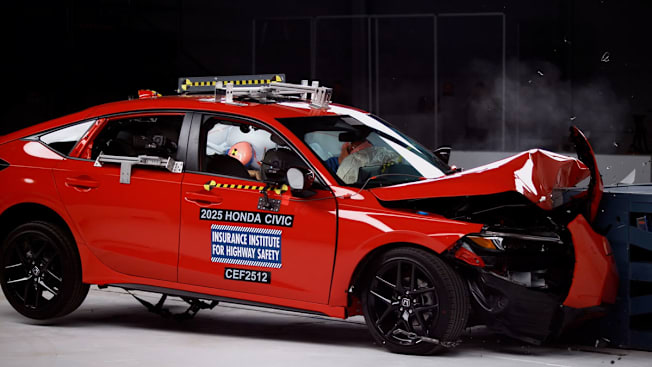
This safety group continues to strengthen the standards for vehicles to earn Top Safety Pick and Top Safety Pick+ ratings
The Insurance Institute for Highway Safety’s moderate overlap crash test of a Honda Civic.
By Keith Barry
The Insurance Institute for Highway Safety released its list of the safest cars on sale, and it includes many popular sedans, SUVs, hatchbacks, and EVs. The tests became even tougher this year, with a focus on rear-seat passenger safety.
The vehicles listed below do a good job of protecting occupants in different kinds of crashes and feature technology that can prevent collisions with other cars and pedestrians. Consumer Reports factors IIHS test results into a vehicle’s Overall Score.
The IIHS, a safety group funded by the insurance industry, crash tests vehicles and evaluates their automatic emergency braking (AEB) and headlight systems. Depending on their performance, the safest vehicles either get a Top Safety Pick (TSP) or Top Safety Pick+ (TSP+) designation. The standards for earning these awards have become stricter over time, which has pushed the auto industry to make ongoing safety improvements that benefit consumers.
The current list includes cars and SUVs from the 2025 model year that have been tested so far. But the IIHS plans to test more vehicles throughout the year and will award more TSP and TSP+ winners accordingly. We’ll update this article as new vehicles are added to the list.
The 2025 Nissan Armada Action earned a rating of Good in the updated moderate overlap front crash test.
Photo: IIHS
2025 IIHS Top Safety Pick and Top Safety Pick+ Winners
Small Cars
Acura Integra (TSP)
Honda Civic Sedan (TSP)
Honda Civic hatchback (TSP+)
Mazda3 hatchback and sedan (TSP+)
Midsized Cars
Honda Accord (TSP+)
Hyundai Ioniq 6 (TSP+)
Toyota Camry (TSP+)
Midsized Luxury Car
Mercedes-Benz C-Class (TSP+)
Large Luxury Car
Genesis G90 (TSP)
Small SUVs
Genesis GV60 (TSP+)
Honda HR-V (TSP+)
Hyundai Ioniq 5 (TSP+)
Hyundai Kona (TSP+)
Hyundai Tucson (TSP+)
Mazda CX-30 (TSP+)
Mazda CX-50 (TSP+)
Subaru Forester (TSP, excluding Wilderness trim)
Subaru Solterra (TSP+)
The 2025 Subaru Forester is a Top Safety Pick.
Photo: IIHS
Midsized SUVs
Chevrolet Traverse (TSP)
Ford Mustang Mach-E (TSP+)
GMC Acadia (TSP)
Honda Pilot (TSP)
Hyundai Santa Fe (TSP+, if built after Nov. 1, 2024)
Kia EV9 (TSP+)
Kia Telluride (TSP+)
Mazda CX-70 and CX-70 PHEV (TSP+)
Mazda CX-90 and CX-90 PHEV (TSP+)
Nissan Pathfinder (TSP+)
Subaru Ascent (TSP)
Midsized Luxury SUVs
Acura MDX (TSP)
Audi Q6 E-Tron (TSP+)
BMW X5 (TSP+)
Buick Enclave (TSP+)
Genesis GV70 (TSP+, if built after April 1, 2024)
Genesis Electrified GV70 (TSP+)
Genesis GV80 (TSP+)
Infiniti QX60 (TSP)
Lexus NX (TSP)
Lincoln Nautilus (TSP+)
Mercedes-Benz GLC (TSP+)
Mercedes-Benz GLE (TSP+, with optional front-crash prevention)
Volvo XC90 (TSP+, if built before December 2024)
Volvo XC90 Plug-In Hybrid (TSP, if built before December 2024)
Large SUVs
Audi Q7 (TSP+)
Infiniti QX80 (TSP+)
Nissan Armada (TSP+)
Rivian R1S (TSP+, if built after August 2024)
Large Pickups
Toyota Tundra (TSP+, crew cab)
Rivian R1T (TSP)
How IIHS Tests Cars
The Insurance Institute for Highway Safety first started releasing crash-test ratings in 1995 and introduced the TSP rating in 2006. To get a TSP rating in 2025, vehicles must earn:
• A rating of Acceptable in the updated moderate overlap front crash test, which mimics what happens if a vehicle crosses a center line and 40 percent of its front end hits a similarly sized oncoming car at 40 mph. This is a stricter requirement than in years past.
• A rating of Good in the side-crash test.
• Ratings of Good in combined passenger- and driver-side small overlap front crash tests, which mimic a crash with a tree, a telephone pole, or the front corner of an oncoming car.
• A rating of Acceptable or Good in pedestrian front crash prevention tests and headlight performance evaluations.
To earn a TSP+ rating, vehicles must meet all of those same qualifications and earn the highest score, Good, in the updated moderate overlap front crash test.
Over time, the IIHS has strengthened the requirements for earning a TSP rating. Last year, for example, vehicles only had to earn an Acceptable rating in the moderate overlap test to earn a TSP+ award. As a result, only 48 models have qualified for TSP and TSP+ awards so far in 2025 compared with 71 in 2024. The vehicles that dropped off the list between last year and this year didn’t get less safe; the criteria got tougher.
The result of an IIHS crash test of a 2025 Hyundai Santa Fe.
Photo: IIHS
Notably, this year’s list doesn’t include any minivans, and only two pickups made the list.
“That’s unfortunate, considering that minivans are marketed as family haulers, and extended cab and crew cab pickups are often used for that purpose,” David Harkey, president of the IIHS, said in a statement.
Incremental changes to crash tests usually reflect data from real-world crashes. The IIHS now does the moderate overlap crash test with a dummy in the seat behind the driver to evaluate rear-seat crash protection. The group added new performance criteria for the rear-seat passenger and pedestrian protection in 2024, and included an updated side-crash test in 2021.
Those changes lead to safer cars because most automakers improve the crash safety of their vehicles over time to meet the more stringent testing requirements, says Jennifer Stockburger, director of operations at CR’s Auto Test Center.
“The IIHS tests challenge vehicles in new ways that better replicate real-world crashes and evaluate crash avoidance technologies,” she says. “Automakers usually respond by redesigning their vehicles to meet those challenges.”
Click through the model names to learn more about the cars, including how they performed in Consumer Reports’ dynamic tests, such as those for braking and emergency handling.
Consumer Reports is an independent, nonprofit organization that works side by side with consumers to create a fairer, safer, and healthier world. CR does not endorse products or services, and does not accept advertising. Copyright © 2025, Consumer Reports, Inc.